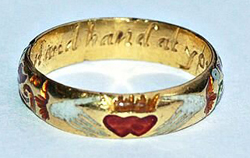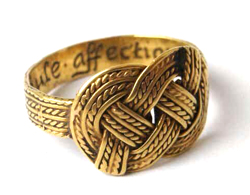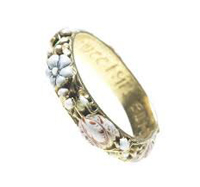Alistir Tait MJVA
We can make some general comments on the traditional matrimonial ring. The Western tradition of the wedding ring dates back, to at least, the ancient Romans and Greeks, the Romans believing that the fourth finger of the left hand contained a ‘vena amoris’ or ‘vein of love’ that led directly to the heart. In Christendom the wedding ring was considered a tangible proof of God’s blessing on the union of a man and a woman.

During the 1648-1660 Commonwealth the Puritans, in their boldness, attempted to abolish the wedding ring because of its associations with bishops and the ritual laid down in the Prayer Book but so strong was the feeling for it that they failed to convince public opinion.
Whether this ring constitutes a symbol of a woman as property of her husband I shall not consider but Samuel Johnson is infamously quoted as saying that a ring “is for the finger of a woman and the nose of a pig for bringing both into subjugation”. What is above doubt is that a betrothal ring is often the plainest of gold bands, a love token and gift of great symbolism and intimacy.

From the fourteenth century it was not uncommon for a betrothal ring to be embellished with a inscription typically on the outside of the ring. Often in Latin or French and the lettering blacked with niello. By the fifteenth century such an inscription was typically on the inside of the ring, known only to the wearer. Indeed, an inscription became commonplace and such was remarked upon in literature by Chaucer. These mottoes known as posies (posies/poesies) or little poems were usually in French (chançon ), for centuries the universal language of love.

Posy rings should not be confused with the tradition of floriography and the decorative floral patterns with which lovers rings have been embellished. More than mere decoration they were symbols with meaning usually conveying a message. This was the ‘language of flowers’. Common in all ages but embraced with enthusiasm by the Victorians this style of cryprological communication was well understood. There was nothing ambiguous about the message represented by a forget-me-not (remembrance) or of a lily (purity).

Some of our posy inscriptions are very appropriate and tender, others are quaint and whimsical. An example might be Dr John Thomas, Bishop of Lincoln, who in 1753 who had been previously married numerous times. He has the following inscribed within his last wife’s wedding ring:
If I survive, I’ll make thee five
Many are more deferential, mindful of death and the sermons from the pulpit. The following from 1637: As I in thee have made my choyce, So in the Lord let vs rejoice

In 1931 Joan Evans (sister of Sir Arthur Evans of Knossos fame) wrote a slim but comprehensive volume ’English Posyies and Posy Rings’ and I also recommend ‘Finger-Ring Lore by William Jones, 1898. The following are a few posys I have selected and I hope you find them both insightful and amusing in varying degrees. Many are touching and loving but never pretentious.
Love and feare God
Love and obye
Til’ death us do part
Hearts united live contented
AS GOD DECREED SO WE AGREED
Correct our ways ; Love all our days
My woldely joye alle my trust + heart, thought, lyfe, and lust (English early 16th cent.)
Observe wedlocke ; Memento mori (English 16th cent.)
If you be pleased, my heart is eased (1596)
If you consent, I am conten t (1674)
I have Obtained what God Ordaind
I joy to find a Constant mind
In Christ & thee my comfort be 1744
In thy sight is my delight
In trial trustie (1596)
I bid adieu to all but you
I choose you not in hope to change
I will be yours while breath endures (1633)
Je suis content, j’ai mon desir
Let love abide God will provide
Let love abaide till death devide
Let patience be thy penance
Love me little love me long (1658)
LOVE SERVE AND OBEY
Love’s Delight Is to unite (1674)
No love in life as a virtuous wife
No friendlier recompence than true obedience (1596)
Outward shape, doth reason hate
Sans peur
The Eye finds, the Heart chooseth (1715)
Vnited hearts death only parts (1624)
Virtue and love is from above
We have a Joy None can destroy
Who would have thought it

During my career in jewellery I have made wedding and commitment rings for many couples. They will often request an inscription within the ring, sometimes something cryptic or personal, special to only themselves and to be shared with no other. Often, just initials and a record of the date of the event. If asked what I suggest they might inscribe, I would reach for my list of inscriptions and although ‘no joy in life as a virtuous wife’ might not suit every occasion I hope that young lovers will feel inspired to find something intimate and unique for them in the tradition of the posy ring.
Alistir Tait
